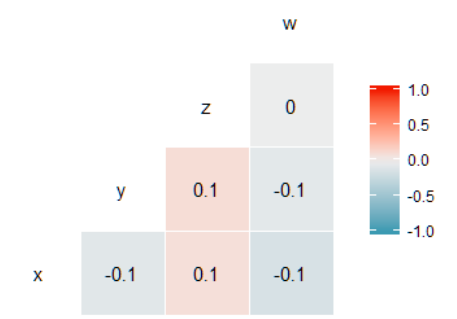Rで色つきの相関係数行列を作る方法
多変量のデータを分析する際に、相関係数行列を作成して変数間の関係を見たいときがあります。
相関係数行列自体はstats::corで作成できすが、このままでは資料に使いづらいです。
x <- rnorm(100, 0, 1) y <- rnorm(100, 0, 1) z <- rnorm(100, 0, 1) w <- rnorm(100, 0, 1) df <- data.frame(cbind(x, y, z, w)) cor(df) > cor(df) x y z w x 1.00000000 -0.1118585 0.06692407 0.11453778 y -0.11185852 1.0000000 0.12882490 -0.11356673 z 0.06692407 0.1288249 1.00000000 0.02012544 w 0.11453778 -0.1135667 0.02012544 1.00000000
キレイに色つきで相関行列を作ってくれる関数としてはGGally::ggcorrなどがあると思います。
library(GGally) library(ggplot2) ggcorr(df, label = TRUE)

GGally::ggcorrでは引数によって見え方を変更できます。以下の記事が網羅的だと思います。
ggcorr: correlation matrixes with ggplot2
ただ、階段状に相関係数行列を見せるやり方は個人的に見辛いです。
できれば以下のような形式が見たいです。

ググってみてもでてこなかったため、自分で関数を作りました。
# correlation_matrix # input : dataframe # output : correlation matrix graph correlation_matrix <- function(df) { # gets columns names colnames <- names(df) # change data.frame into matrix # and if there are non-numeric columns , convert them into numeric mat <- df %>% sapply(as.numeric) # create correlation matrix cormat <- cor(mat) # prepare parameters for ggplot n <- ncol(cormat) x <- c() for (i in 1:n) { x <- append(x, rep(i, n)) } y <- rep(1:n, n) # convert matrix into dataframe cormat <- data.frame(cormat) %>% gather(key = "type", value = "value") %>% mutate(x = x, y = y) # create correlation matrix with color scale cormat %>% ggplot() + geom_tile(aes(x = x, y = y, fill = value)) + geom_text(aes(x = x, y = y, label = round(cormat$value, 2)), size = 3) + scale_x_continuous(breaks = 1:n, labels = colnames) + scale_y_continuous(breaks = 1:n, labels = colnames) + theme(axis.title.x = element_blank(), axis.title.y = element_blank()) + ggtitle("Correlation Matrix") + scale_fill_gradient(low = "white", high = "red", name = "scale") }
結果は以下のようになります。
# function test x <- rnorm(100, 0, 1) y <- rnorm(100, 0, 1) z <- rnorm(100, 0, 1) w <- rnorm(100, 0, 1) df <- data.frame(cbind(x, y, z, w)) correlation_matrix(df)

自分好みの相関係数行列が得られました。
試しに、実際のデータで相関係数行列を作ってみようと思います。
以下で作成したNBAのデータを使用します。
library(nbastats) library(tidyverse) library(GGally) # target columns targets <- c( "G", # games "MP", # minutes played "FG", # field goals "3P", # 3 point field goals "2P", # 2 point field goals "FT", # free throws "AST", # assists "STL", # steals "BLK", # blocks "TOV", # tunrovers "PF", # personal fouls "PTS" # points ) # filter 2017 records stats <- seasons_stats %>% filter(Year == 2017) # remove unnecessary columns stats <- stats[, targets] # create correlation matrix correlation_matrix(stats)

自作の関数を使って相関係数行列が作成できました。
結果を少し見てみて、以下のような分析をしてみました。
・3P(3ポイント成功数)とBLK(ブロック数)はほとんど相関がない。(0.13)
⇒シューターは小柄な選手が多いためブロック数は少ない?
・AST(アシスト数)とBLK(ブロック数)はほとんど相関がない。(0.23)
⇒アシスト数が多いゲームメイカーは小柄な選手が多いため、ブロック数が少ない?
・AST(アシスト数)とTOV(ターンオーバー数)は相関が高い。(0.89)
⇒アシスト数が多いゲームメイカーはパスを出す回数が多いため、その分ターンオーバー数も多い?
以上